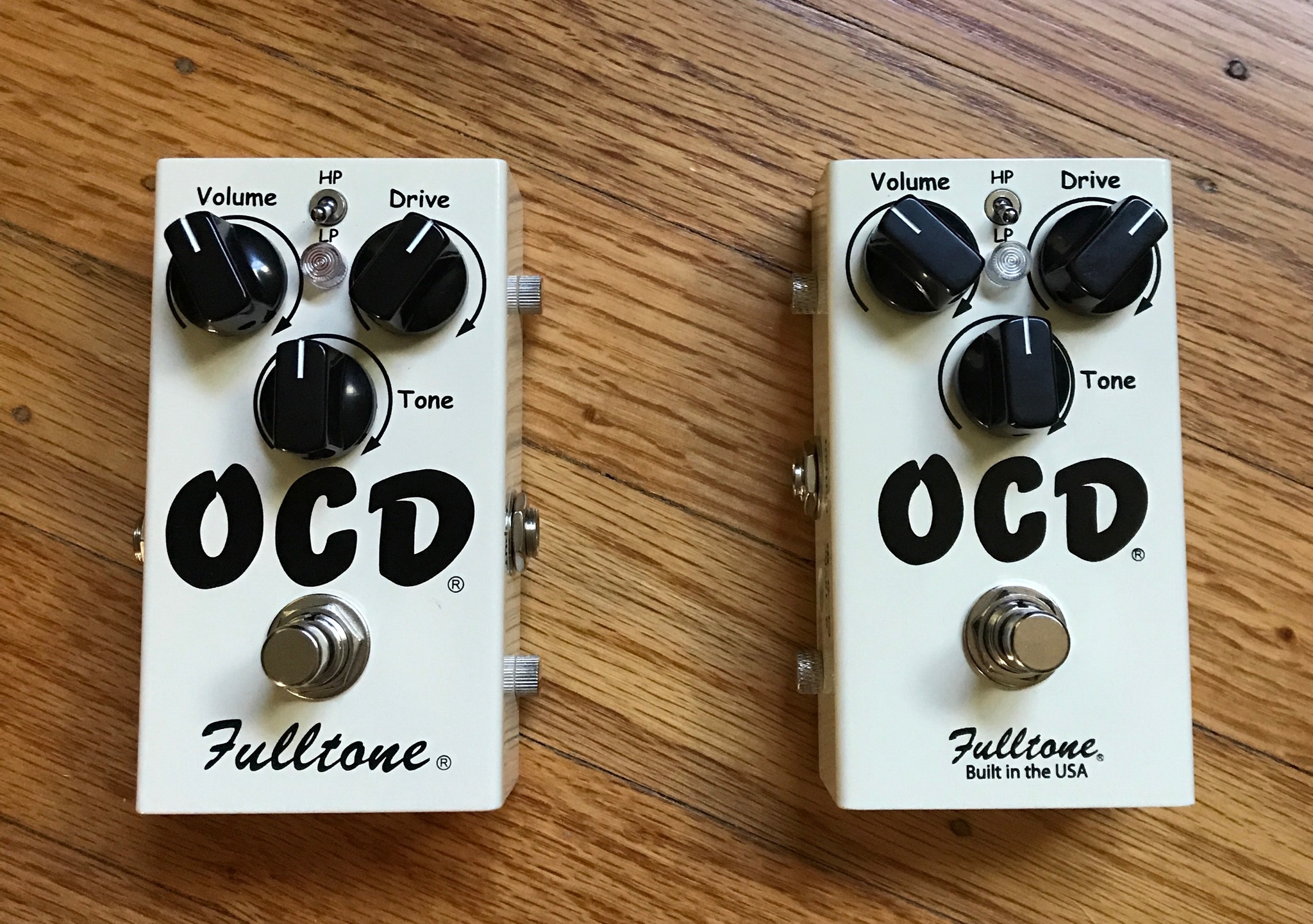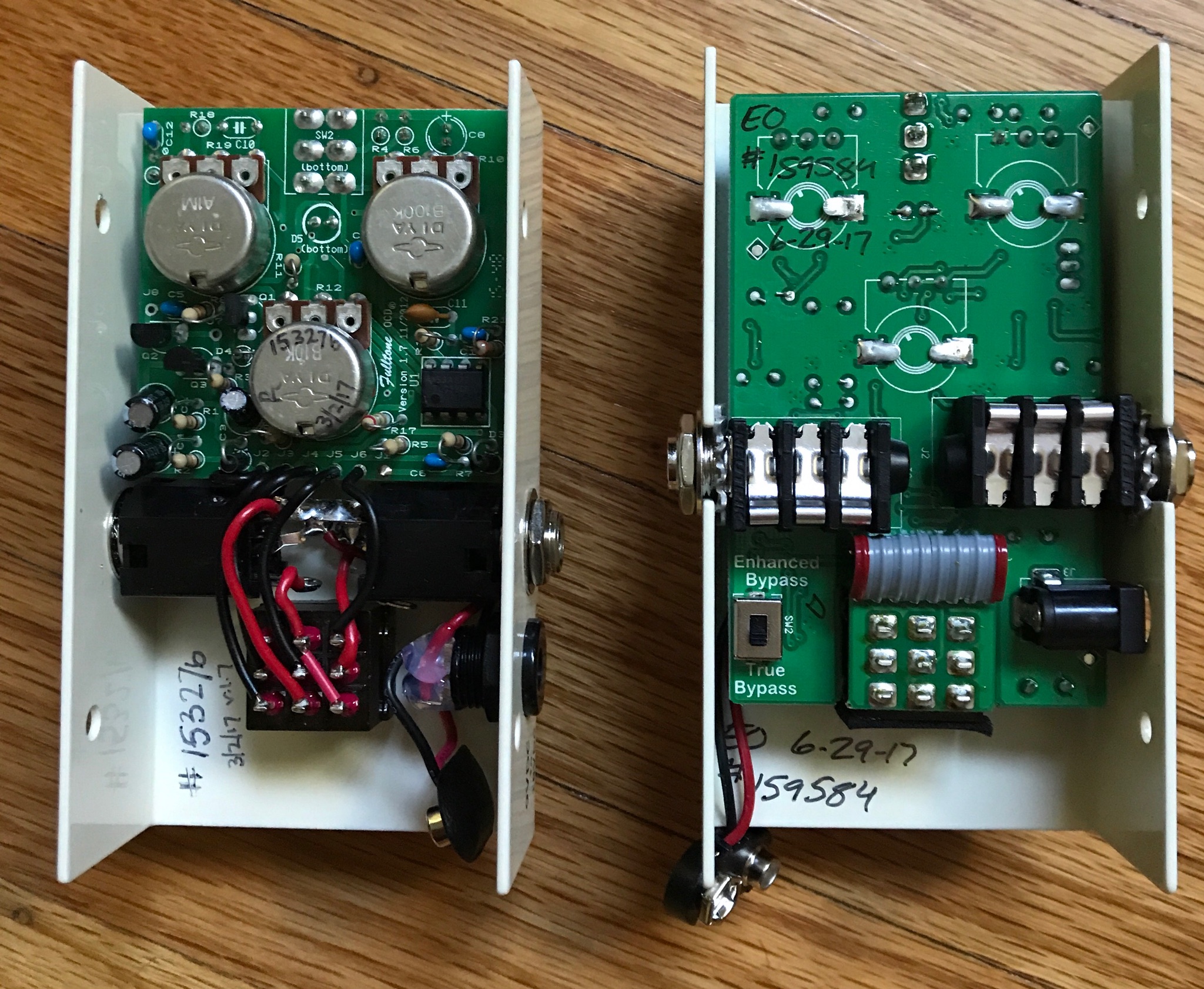 The Fulltone OCD, otherwise known as the Obsessive Compulsive Drive, is not only one of Mike Fuller’s best-selling overdrive/distortion units of all time, it has also been heralded and awarded accolades by the media since its introduction 12 years ago. Along the way, Mike has continued to make mild tweaks to the circuits and I remember playing through and trying each version myself. Mike continued to be obsessive about his OCD and I enjoyed listening to the results.
The Fulltone OCD, otherwise known as the Obsessive Compulsive Drive, is not only one of Mike Fuller’s best-selling overdrive/distortion units of all time, it has also been heralded and awarded accolades by the media since its introduction 12 years ago. Along the way, Mike has continued to make mild tweaks to the circuits and I remember playing through and trying each version myself. Mike continued to be obsessive about his OCD and I enjoyed listening to the results.
Now in 2017, Fulltone has launched what it is being dubbed as the “final” version of the OCD, the OCD V2. The OCD V2 packs a number of new updates and features, so we took a look to compare it to its predecessor, the OCD version 1.7.
Many collectors and players over the years have argued on forums and elsewhere to chime in on which version of the OCD they felt was best. This is a difficult topic with this overdrive, or any other overdrive for that matter since an overdrive or distortion box is so dependent on what it is being used with.

Knowing Mike Fuller’s love for vintage amps and guitars, it’s a safe bet that the OCD will shine best through a classic Fender circuit such as a mid-60s blackface or other more brightly-voice amplifiers. No doubt, he used these amps as his personal sonic testbed. These days, amplifers, especially those with multiple gain channels, tend to be voiced a bit more dark. But in the 60s and 70s, a brightly voiced amplifier was not done so out of a desire per se to simply offer excessive treble, it was done to be able to stand out in the mix. I’ve found that playing the OCD through a clean channel of an amp like a Mesa Boogie that contains a vintage 30 speaker is much less satisfying than putting the OCD in front of a 1960’s Super Reverb. In the Mesa, the OCD (regardless of version) will be muddy unless you significantly bump up the presence and treble. In the Fender, the OCD is heavenly.
I recall the very first version of the OCD. Like the Klon Centaur, its circuit was shrouded in mystery as it contained gooped epoxy on its circuit board covering its secrets. The OCD was immediately a hit and had a particular crunch in HP mode that was pure and raw and rock and roll, and in LP mode, it could provide a more transparent overdrive for the user who wanted to just add a bit more of the same characteristic of the guitar and amp – but with overdrive.
While arguments continue on the web (guitarists tend to have an “older is better” attitude when it comes to gear), I can say that I enjoyed the very first OCD, but it was a bit heavy on bass frequencies and slightly mid scooped. Along the way, each successive version was improved (to my ears) as I certainly seem to be in agreement to the mild tweaks that Mike Fuller made with his subsequent OCD versions.
Last year, Fulltone claimed the version 1.7 was its best version yet, and after purchasing one, I agreed. It was well balanced, had a nice rounded midrange and was a bit smoother compared with my earlier OCDs I had owned and played.
Now with Fulltone’s “final” version (we’ll see!), the OCD V2 employees a couple of new features that set it apart from its excellent version 1.7 predecessor. First, it delivers an internal switch for selecting “true bypass” or “enhanced bypass”. As times have changed and people use an extensive amount of pedals in their sonic chain, Mike wanted to design an option to include a buffer which could help avoid dramatic signal loss that can occur when a large number of true bypass pedals are chained together into a rig. The output buffer helps make the sound consistent regardless of how many pedals you have in your chain. Fulltone also states that it has a positive effect on the sound by reducing loading on the pedal’s hard-clipping stage, which allows more sustain of both sound and overtones.

Opening up the OCD to play with the switch and try out both modes, I was somewhat surprised to see a change in Fulltone’s construction method with the v2 OCD. Gone are the separately-mounted jacks, DC power supply and hand-soldered footswitch, and in their place are all board-mounted components. More surprising still was the use of miniature surface-mounted technology (SMT) components and gone are the majority of standard through-hole printed circuit board (PCB) components.
This trend in surface-mounted components in pedal manufacturing is fairly new and many manufacturers, boutique and mass market, have moved to this technology. When you buy a mini pedal, it is all SMT. The upside is lower cost to the manufacturer, which should translate to a lower price for the user, as well as their being more parts availability for the manufacturer. The downside is servicing can be a little more challenging (although the likely solution is simply rip and replace the boards during a failure) and there is some debate over the longevity of some of the components – especially capacitors – in SMT based designs over time when used for audio applications. Fulltone’s FAQ section on the web boasts about the company’s use of the highest quality components and NOT using SMT because it wants its customers to enjoy its pedals for a lifetime. But that FAQ seems now due for an update.
Getting back to the enhanced vs. true bypass modes, indeed the OCD v2 is set by default from the factory for enhanced bypass mode. And as was claimed, the pedal does have a little bit more sustain when comparing it with the version 1.7. Regardless of how it is built, it’s a phenomenal sounding pedal.
Fulltone also raised the input impedance to 1 mega ohms from 330K by using a Class A discrete 2N5457 JFET input section. Those numbers might not mean anything to the layman, but when using either a single-coil equipped Fender Stratocaster or a humbucker-equipped Les Paul, the sonic result of this and the other tweaks is the tone has a bit more girth in the upper low-end frequencies just below the midrange. The OCD V2 is smoother still, providing an overall wider sonic palette that just feels good to play. It sounds excellent!
Not that the V1.7 isn’t great as well. They are just different. The V2 stands out as a better stand-alone overdrive if you are seeking a flatter frequency response, and more transparency represented in the signal path. The V1.7 certainly is by no means mid-humped like a Tube Screamer, but it does have some more emphasis in the mids.
If you play through a cranked amp and are looking to kick on the OCD for a solo boost, the V1.7 may be best. The OCD V2.0 in this application may bring in a little too much low-end emphasis. Again, it really depends on the rig you use and whether you need that low end signal being brought in from the pedal or not.
At the end of the day, it’s all splitting hairs as an OCD fundamentally still sounds characteristically like an OCD. But we can see that Mike Fuller has enjoyed playing with the OCD’s circuit and obsessing over sonic improvement s as he’s deemed fit. If you’re a fan of the OCD, you’ll no doubt continue to be with either of these two versions. It’s like ice cream, the variety and enjoyment are all good, whether you like vanilla and vanilla bean. No doubt the Fulltone OCD will continue to make new fans for years to come. And at $118.15 street price, the v2 Fulltone OCD remains a tremendous bang for the buck.